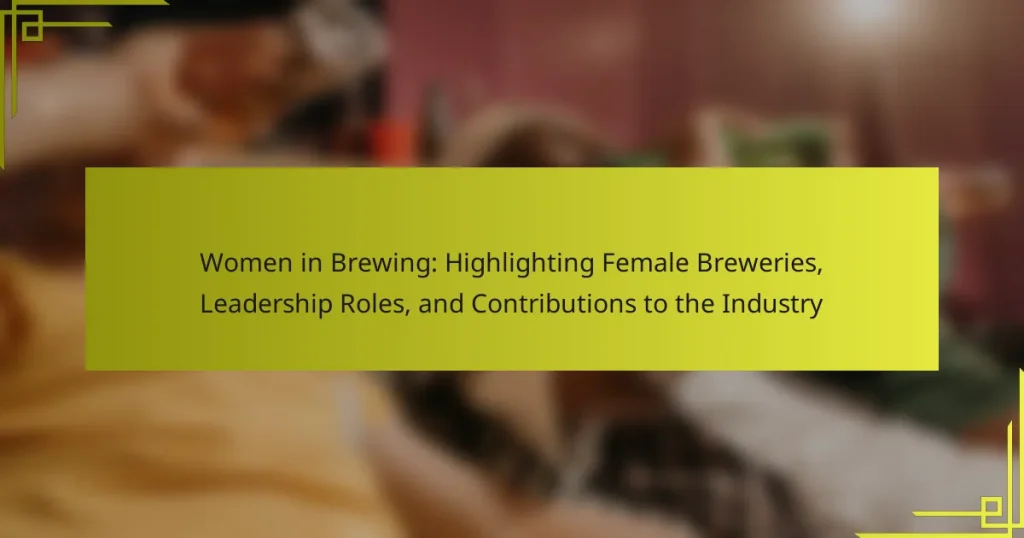Women play a significant role in the brewing industry, contributing as brewers, owners, and leaders. Historically underrepresented, they now account for approximately 30% of the U.S. brewing workforce, with a notable increase in female-owned breweries by 50% in recent years. Female brewers enhance creativity and innovation, often producing a wider variety of beer styles and focusing on sustainability practices. Women also hold key leadership positions, influencing business strategies and fostering community engagement, which reflects a growing recognition of diversity’s impact on industry performance. Their involvement is crucial in shaping the future of the brewing sector.

What role do women play in the brewing industry?
Women play a significant role in the brewing industry. They contribute as brewers, owners, and leaders in various capacities. Women have been historically underrepresented in brewing but are increasingly gaining visibility. According to the Brewers Association, women represent approximately 30% of the brewing workforce in the U.S. This figure highlights their growing participation. Female brewers often bring unique perspectives and flavors to beer production. Women-owned breweries are on the rise, showcasing diversity in the industry. Additionally, women hold leadership positions, influencing business strategies and company cultures. Their contributions enhance innovation and community engagement within the brewing sector.
How has the representation of women in brewing evolved over time?
The representation of women in brewing has significantly evolved over time. Historically, women played crucial roles in brewing, especially in domestic settings. In the Middle Ages, women were often the primary brewers in households. This changed during the Industrial Revolution when brewing became commercialized and male-dominated.
In recent decades, the craft beer movement has led to a resurgence of women in the industry. Women now hold various leadership roles and ownership positions in breweries. According to the Brewers Association, the percentage of female brewers has increased from 4% in 2013 to 22% in 2021.
This growth reflects broader societal changes towards gender equality and increased support for female entrepreneurs. Events like Women’s Beer Week and initiatives such as the Pink Boots Society further promote female representation in brewing. Thus, the evolution of women’s representation in brewing showcases both historical significance and contemporary progress.
What historical milestones have marked women’s contributions to brewing?
Women have significantly contributed to brewing throughout history. In ancient civilizations, women were often the primary brewers. They produced beer for daily consumption and special occasions. In the Middle Ages, women brewed in monasteries and homes, contributing to local economies. The Beer Purity Law of 1516 in Germany recognized women’s brewing practices. In the 19th century, women began to enter the commercial brewing industry. Notably, in 1888, the first female brewer, Ellen McLoughlin, opened a brewery in the U.S. The Prohibition era saw women taking on more roles in illegal brewing. Today, women hold leadership positions in major breweries and craft beer companies. The rise of female-centric breweries in the 21st century highlights ongoing contributions.
How do cultural perceptions of women in brewing differ globally?
Cultural perceptions of women in brewing vary significantly across the globe. In some regions, women are celebrated as key contributors to brewing traditions. For instance, in Belgium, women have historically played a crucial role in family-owned breweries. Conversely, in many cultures, brewing is still seen as a male-dominated industry. In countries like Germany, traditional norms often limit women’s visibility in brewing roles.
In the United States, the craft beer movement has fostered a more inclusive environment for women. Statistics show that women-owned breweries have increased by 400% since 2014. Meanwhile, in parts of Africa, women are recognized for their brewing skills in local communities, but often lack access to formal recognition or resources.
Cultural attitudes towards women in brewing are influenced by historical, social, and economic factors. These factors shape the opportunities available to women in the industry. Overall, while some regions embrace women in brewing, others still face significant barriers.
What are the key challenges faced by women in brewing?
Women in brewing face several key challenges. These include gender bias in a male-dominated industry. Women often encounter difficulties in gaining access to funding and resources. They may also experience a lack of mentorship and networking opportunities. The brewing culture can be unwelcoming, which affects women’s retention in the field. Additionally, women often struggle for recognition and leadership roles. Statistics show that only about 4% of head brewers in the U.S. are women. This underrepresentation highlights systemic barriers within the industry.
What barriers to entry exist for women aspiring to join the brewing industry?
Barriers to entry for women in the brewing industry include lack of access to funding, limited networking opportunities, and gender bias. Women often face challenges in securing financial support for starting breweries. According to a 2021 study by the Brewers Association, only 4% of brewery owners are women. Networking events are often male-dominated, making it difficult for women to build connections. Additionally, gender stereotypes can lead to discrimination in hiring and promotion. A survey by the Pink Boots Society found that 62% of women in brewing experienced gender bias. These barriers contribute to the underrepresentation of women in the industry.
How do workplace dynamics affect female brewers and leaders?
Workplace dynamics significantly impact female brewers and leaders. Gender biases can hinder their advancement in the industry. A study by the Brewers Association found that women hold only 7% of brewery leadership positions. This underrepresentation can lead to a lack of mentorship opportunities for aspiring female brewers. Additionally, workplace culture often prioritizes male-dominated networking practices. Such environments can create barriers to collaboration and support for women. Furthermore, female leaders may face challenges in asserting authority in traditionally male spaces. These dynamics can discourage women from pursuing long-term careers in brewing. Overall, the interplay of gender biases and workplace culture shapes the experiences of female brewers and leaders.

What are the contributions of female breweries to the industry?
Female breweries contribute significantly to the industry by promoting diversity and innovation. They bring unique perspectives that enhance creativity in brewing. Research indicates that breweries with female leadership often produce a wider variety of beer styles. According to the Brewers Association, female-owned breweries have increased by 50% in recent years. This growth reflects a shift towards inclusivity in the craft beer market. Female brewers also focus on sustainability practices, contributing to environmentally friendly production methods. Their involvement fosters community engagement through local collaborations and events. Overall, female breweries play a crucial role in shaping the future of the brewing industry.
How do female-led breweries differ from their male counterparts?
Female-led breweries often prioritize inclusivity and community engagement more than male-led counterparts. They tend to create welcoming environments for diverse customers. Research indicates that female brewers are more likely to support local businesses and sustainable practices. For instance, a study by the Brewers Association shows that women-owned breweries often engage in community-oriented events. They also frequently focus on innovative flavors and styles, reflecting a distinct approach to brewing. This is supported by data from industry surveys highlighting unique product offerings from female-led establishments. Moreover, female-led breweries often emphasize collaboration over competition, fostering a supportive network within the industry.
What unique brewing styles or flavors have emerged from female breweries?
Unique brewing styles and flavors have emerged from female breweries, showcasing creativity and innovation. Many female brewers focus on incorporating local ingredients, resulting in distinctive regional flavors. For example, some breweries utilize fruits and herbs traditionally associated with female culinary practices. Others experiment with floral notes, creating beers that highlight botanicals like hibiscus and chamomile.
Additionally, female brewers often emphasize balance and drinkability in their styles. This can lead to the development of sessionable beers that appeal to a broader audience. The rise of sour beers has also been influenced by women, with many breweries producing unique sour ales that blend traditional brewing techniques with contemporary flavors.
The Craft Beer Association reports an increase in female-led breweries, which has encouraged diverse flavor profiles and styles. This trend reflects a growing recognition of women’s contributions to the brewing industry.
How do female breweries impact local communities and economies?
Female breweries positively impact local communities and economies by fostering inclusivity and driving economic growth. They create jobs within the community, contributing to local employment rates. Research indicates that women-owned businesses, including breweries, generate significant revenue. According to a study by the National Women’s Business Council, women-owned businesses have been growing at a rate of 5% annually. Female breweries also promote local sourcing of ingredients, benefiting local farmers and suppliers. They often engage in community initiatives, supporting local charities and events. This engagement strengthens community ties and enhances the local culture. Female-led breweries contribute to a diverse marketplace, attracting a broader customer base. Their presence encourages other women to enter the brewing industry, promoting gender equality in a traditionally male-dominated field.
What initiatives support women in brewing?
Initiatives that support women in brewing include organizations like the Pink Boots Society. This nonprofit aims to assist women in the brewing industry through education and networking. They offer scholarships for brewing education and host events to promote female leadership. Another initiative is the Brewers Association’s Diversity, Equity, and Inclusion program. This program provides resources and support for underrepresented groups in brewing. Additionally, various mentorship programs connect experienced female brewers with newcomers. These initiatives help create a more inclusive environment in the brewing industry.
What organizations are dedicated to promoting female brewers?
Organizations dedicated to promoting female brewers include the Pink Boots Society and the Brewers Association’s Diversity, Equity, and Inclusion initiatives. The Pink Boots Society supports women in the brewing industry through scholarships and networking opportunities. It was founded in 2007 and has chapters across the United States and internationally. The Brewers Association promotes inclusivity and diversity within the brewing community. Their initiatives aim to support underrepresented groups, including women brewers. Both organizations provide resources, education, and community to empower female brewers and enhance their visibility in the industry.
How do mentorship programs benefit women in the brewing industry?
Mentorship programs benefit women in the brewing industry by providing guidance and support. These programs help women navigate challenges specific to the industry. They offer networking opportunities that can lead to career advancement. Mentorship fosters skill development through knowledge sharing. Research indicates that women in mentorship programs report increased confidence and job satisfaction. A study by the Brewers Association found that mentorship enhances retention rates among women in brewing. This support system encourages diversity and innovation within the industry. Overall, mentorship programs are crucial for empowering women in brewing careers.

What leadership roles do women hold in brewing?
Women hold various leadership roles in brewing, including positions such as brewmaster, brewery owner, and head of marketing. Many women serve as executives in large brewing companies, overseeing operations and strategy. Women also lead craft breweries, contributing to innovation and community engagement. According to the Brewers Association, about 25% of breweries in the U.S. have at least one female owner or co-owner. Female leadership is increasingly recognized for enhancing diversity and creativity in the industry. Studies show that companies with diverse leadership teams perform better financially. Women in brewing are also involved in mentorship programs to support future generations. These roles demonstrate the growing influence of women in a traditionally male-dominated field.
How can women advance to leadership positions within brewing companies?
Women can advance to leadership positions within brewing companies by actively seeking mentorship and networking opportunities. Engaging with industry organizations can provide valuable connections and insights. Pursuing further education in brewing or business management enhances qualifications. Gaining experience in various roles within the company builds a comprehensive skill set. Participating in leadership training programs fosters essential management skills. Advocating for diversity and inclusion initiatives can create supportive environments. Research indicates that companies with diverse leadership teams perform better. According to a McKinsey report, gender-diverse companies are 21% more likely to outperform their peers.
What skills are essential for women to succeed in brewing leadership roles?
Essential skills for women to succeed in brewing leadership roles include strong communication, strategic thinking, and industry knowledge. Communication skills help in effectively conveying ideas and collaborating with teams. Strategic thinking allows for better decision-making and planning for business growth. Industry knowledge is crucial for understanding brewing processes and market trends. Leadership skills, including team management and conflict resolution, are also vital. Networking abilities can aid in building industry connections. Financial acumen is important for managing budgets and resources effectively. Adaptability is necessary to navigate the evolving brewing landscape. Finally, passion for brewing drives innovation and inspires teams.
How do female leaders influence company culture in breweries?
Female leaders significantly influence company culture in breweries by promoting inclusivity and collaboration. Their leadership styles often emphasize teamwork and open communication. This approach fosters a supportive environment that encourages diverse perspectives. Research shows that companies with female leadership report higher employee satisfaction. For instance, a study by McKinsey & Company found that organizations with more women in leadership roles are 21% more likely to outperform their counterparts. Female leaders also prioritize social responsibility and sustainability, aligning brewery practices with community values. This alignment strengthens brand loyalty and enhances the company’s reputation. Overall, female leaders drive positive cultural shifts that benefit both employees and the business.
What success stories exemplify women’s leadership in brewing?
Successful stories of women’s leadership in brewing include the rise of notable female brewers such as Kim Jordan, co-founder of New Belgium Brewing. Under her leadership, the company became one of the largest craft breweries in the U.S. Jordan’s commitment to sustainability and community engagement has set industry standards. Another example is Teri Fahrendorf, the first female brewmaster in the U.S. She founded the Pink Boots Society, which supports women in the brewing profession. Additionally, the success of breweries like Elysian Brewing, co-founded by women, showcases the impact of female leadership. These stories highlight the growing influence and achievements of women in the brewing industry.
Who are some notable female figures in the brewing industry?
Notable female figures in the brewing industry include Kim Jordan, co-founder of New Belgium Brewing. She played a significant role in promoting sustainability and innovation in brewing. Another key figure is Teri Fahrendorf, the first female brewmaster in the U.S. She founded the Pink Boots Society to support women in the craft beer industry. Additionally, Julia Herz is a prominent advocate for craft beer and has been influential in beer education. These women have made impactful contributions to the industry, shaping its landscape and promoting diversity.
What lessons can be learned from their journeys?
Women in brewing demonstrate resilience and innovation in a traditionally male-dominated industry. Their journeys highlight the importance of mentorship and collaboration. Female brewers often emphasize community-building as a key to success. They showcase the value of diverse perspectives in product development. Many women have overcome significant barriers, proving that determination leads to breakthroughs. Their experiences underline the need for supportive networks in professional growth. Studies show that companies with women in leadership roles perform better financially. This reinforces the significance of gender diversity in driving industry advancements.
What practical tips can women consider when pursuing a career in brewing?
Women pursuing a career in brewing should seek education and training in brewing science. Formal programs or workshops can provide foundational knowledge. Networking with industry professionals can open doors to job opportunities. Joining women-focused brewing organizations can offer support and mentorship. Gaining hands-on experience through internships is crucial for skill development. Attending brewing festivals and events can enhance visibility in the community. Staying updated on industry trends helps in adapting to changes. Lastly, advocating for oneself in the workplace is essential for career advancement.
Women in brewing represent a growing and vital segment of the industry, holding roles as brewers, owners, and leaders. The article examines the historical evolution of women’s representation in brewing, highlighting significant milestones and the impact of cultural perceptions globally. It addresses the challenges faced by women, including gender bias and barriers to entry, while showcasing the contributions of female breweries to innovation and community engagement. Additionally, the article emphasizes the importance of mentorship and leadership roles, featuring notable figures and success stories that exemplify women’s influence in shaping the brewing landscape.




